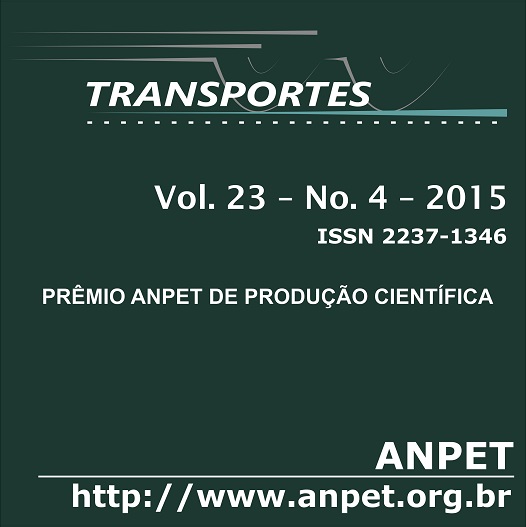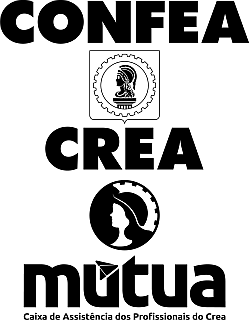Influência da estrutura urbana na decisão de realizar viagens a pé em Porto Alegre
DOI:
https://doi.org/10.14295/transportes.v23i4.924Palavras-chave:
estrutura urbana, modelos de escolha discreta, viagens a pé.Resumo
Estudos realizados em países desenvolvidos revelam que mudanças nas características da estrutura urbana podem ter impacto significativo sobre o padrão de viagens. Este artigo visa: (i) testar se estas relações reportadas na literatura sobre a relação entre a estrutura urbana e comportamento de viagem são mantidas numa cidade como Porto Alegre; (ii) testar se a magnitude do impacto destas características se mantém; e (iii) comparar o impacto na decisão de caminhar em relação aos resultados obtidos num estudo anterior para a frequência de viagens a pé. Modelos logit binomial e logit mistos foram estimados para modelar a decisão de caminhar. Elasticidades da decisão de caminhar com relação às variáveis da estrutura urbana foram calculadas. Os resultados mostram que, em Porto Alegre, a estrutura urbana influencia a decisão de realizar viagens a pé. No entanto, existem diferenças nas magnitudes do impacto de algumas variáveis. As elasticidades calculadas para a decisão de caminhar com relação às variáveis da estrutura urbana foram maiores do que em outros estudos. Valores de elasticidades podem ser usados em previsões de modelos de demanda.
Downloads
Referências
Amâncio, M. A. (2005) Relacionamento entre a forma urbana e as viagens a pé. Dissertação de Mestrado. Departamento de Engenharia Civil, Universidade Federal de São Carlos, São Paulo.
Baran, P.; D. Rodríguez, e A. Khattak (2008) Space Syntax and Walking in a New Urbanist and Suburban Neighborhoods. Journal of Urban Design, v. 13, n. 1, p. 5–28. DOI: 10.1080/13574800701803498
Ben-Akiva, M. e S. R. Lerman, (1985). Discrete choice analysis - Theory and applications to travel demand. MIT Press, Cambridge.
Ben-Akiva, M.E e D. Bolduc, (1996) Multinomial probit with a logit kernel and a general parametric specification of the covariance structure. Working Paper, Economique, Université Laval, Québec.
Ben-Akiva, M.; D. Bolduc e J. Walker (2003) Specification, Identification, and Estimation of the Logit Kernel (or Continous Mixed Logit) Model. Working Paper apresentado no 5th Invitational Choice Symposium, Asilomar, California.
Bierlaire, M. (2003) BIOGEME - A free package for the estimation of discrete choice models, 3rd Swiss Transportation Research Conference, Switzerland.
Boarnet, M. G.; M. Greenwald e T. McMillan (2008) Walking, urban design, and health: Toward a cost-benefit analysis framework. Journal of Planning Education and Research, v. 27, n. 3, p. 341–358. DOI: 10.1177/0739456X07311073
Brownstone, D.; K. E. Train (1999) Forescating new product penetration with flexible substitution patterns. Journal of Econometrics, v. 89, p. 109-129.
Cao, X.; Handy, S. e P. Mokhtarian (2006). The Influences of the Built Environment and Residential Self-Selection on Pedestrian Behavior: Evidence from Austin, TX. Transportation, v. 33, n. 1, p.1-20. DOI: 10.1007/s11116-005-7027-2
Cervero, R. e K. Kockelman (1997) Travel demand and the 3Ds - Density, diversity, and design. Transportation Research D, v. 2, n. 3, p. 199–219. DOI: 10.1016/S1361-9209(97)00009-6
Cervero, R. e M. Duncan (2003) Walking, bicycling, and urban landscapes - evidence from San Francisco Bay Area. American Journal of Public Health, v. 93, n. 9, p. 1478-1483. DOI: 10.2105/AJPH.93.9.1478
Cervero, R.; O. Sarmiento; E. Jacoby; L.F. Gomez e A. Neiman (2009). Influences of Built Environments on Walking and Cycling-Lessons from Bogotá. International Journal of Sustainable Transportation, v. 3, n. 4, p. 203- 226. DOI: 10.1080/15568310802178314
Chatman, D. G (2009) Residential self-selection, the built environment, and nonwork travel - Evidence using new data and methods. Environment and Planning A, v. 41, n. 5, p. 1072-1089. DOI: 10.1068/a4114
Deus, L. R. (2008) A influência da forma urbana no comportamento de viagem das pessoas: Estudo de caso em Uberlândia, MG. Dissertação de Mestrado. Departamento de Engenharia Civil, Universidade Federal de São Carlos, São Paulo.
Domencich, T.; D. Mcfadden (1972) A disaggregated Behavioral Model of Urban Travel Demand. Report Nº CRA-156-2, Charles River Associates, Inc. Cambridge, Massachusetts.
Ewing, R. e R. Cervero (2001) Travel and the Built Environment - A Synthesis. Transportation Research Record - Journal of the Transportation Research Board 1780, p. 87-114. DOI: 10.3141/1780-10
Ewing, R.; M. J. Greenwald; M. Zhang; J. Walters; M. Feldman; R. Cervero e J. Thomas (2009). Measuring the impact of urban form and transit access on mixed use site trip generation rates - Portland pilot study. DC: U.S. Environmental Protection Agency, Washington.
Ewing, R. e R. Cervero (2010) Travel and the Built Environment - A Meta-Analysis. Journal of the American Planning Association, v. 76, n. 3, p. 265 – 294. DOI: 10.1080/01944361003766766
Fernandes, K. D.; M. L. Maia; C. Ferraz (2008) Forma urbana e deslocamentos pendulares: análise dos bairros de Casa Caiada e Jardim Brasil em Olinda/PE. In: XXII ANPET Congresso de Pesquisa e Ensino em Transportes. Fortaleza.
Frank, L. D. e P. O. Engelke (2001) The Built Environment and Human Activity Patterns - Exploring the Impacts of Urban Form on Public Health. Journal of Planning Literature, v. 16, p. 202-218. DOI: 10.1177/08854120122093339
Frank, L. D.; S. Kavage; M. Greenwald; J. Chapman e M. Bradleyn (2009) I-PLACE3S health & climate enhancements and their application in King County. King County Health Scape, Seattle, WA.
Handy, S. L.; M. G. Boarnet; R. Ewing e R. E. Killingsworth (2002) How the built environment affects physical activity. Views from Urban Planning. American Journal of Preventive Medicine, 23(2). p. 64-73. DOI:10.1016/S0749-3797(02)00475-0
Larranaga, A. M. L. (2012) Estrutura urbana e viagens a pé. Tese de Doutorado. Programa de Pós-Graduação em Engenharia da Produção, Universidade Federal do Rio Grande do Sul, Porto Alegre.
Larranaga, A. M. L.; L. I. Rizzi; J. Arellana; O. Stramb e H. Cybis (2014) The Influence of built environment and travel attitudes on walking: a case study of Porto Alegre, Brazil. International Journal of Sustainable Transportation. DOI:10.1080/15568318.2014.933986
Lee, C. e A. V. Moudon (2006) Correlates of Walking for Transportation or Recreation Purposes. Journal of Physical Activity and Health, v. 3, n. S1, p. S77–S98.
Manski, C. (1977). The structure of random utility models. In: Theory and Decision, v. 8, issue 3, p. 229-254. DOI: 10.1007/BF00133443
Mcfadden, D. (1974). Conditional logit analysis of qualitative choice behavior. In: P Zarembka (ed.) Frontiers in Econometrics. Academic Press, New York.
Mcfadden, D.; K. Train (2000) Mixed MNL Models for Discrete Response. Journal of Applied Econometrics, sep/oct., v. 15, issue 5, p. 447-470, John Wiley & Sons, Ltd., New York.DOI: 10.1002/1099-1255(200009/10)15:5<447:AID-JAE570>3.0.CO;2-1
Naess, P. (2005) Residential location affects travel behavior - but how and why? The case of Copenhagen metropolitan area. Progress in Planning, v. 63, issue 2, p. 167-257. DOI: 10.1016/j.progress.2004.07.004
Ortúzar, J. D. e L. G. Willumsen. (2011) Modelling Transport. 3 th ed. Wiley, Chichester.
Sehatzadeh, B.; R. B. Noland e M. D. Weiner (2011) Walking frequency, cars, dogs, and the built environment. Transportation Research Part A, v. 45, p. 741-754. DOI:10.1016/j.tra.2011.06.001
Wewers, M. E. e N. K. Lowe (1990). A critical review of visual analogue scales in the measurement of clinical phenomena. Research in Nursing and Health, v. 13, p. 227-236. DOI:10.1002/nur.4770130405
Zegras, C. (2004) The Influence of Land Use on Travel Behavior - Empirical Evidence from Santiago de Chile. TRB 2004 Annual Meeting of the Transportation Research Board - Travel Demand and Land Use. 83th Annual Meeting, Washington.
Zegras, C. (2010) The Built Environment and Motor Vehicle Ownership and Use - Evidence from Santiago de Chile. Urban Studies, v. 47, n. 8.
DOI: 10.1177/0042098009356125
Downloads
Publicado
Como Citar
Edição
Seção
Licença
Ao submeter um manuscrito para publicação neste periódico, todos os seus autores concordam, antecipada e irrestritamente, com os seguintes termos:
- Os autores mantém os direitos autorais e concedem à Transportes o direito de primeira publicação do manuscrito, sem nenhum ônus financeiro, e abrem mão de qualquer outra remuneração pela sua publicação pela ANPET.
- Ao ser publicado pela Transportes, o manuscrito fica automaticamente licenciado sob a Licença Creative Commons CC BY 4.0. Esta licença permite o seu compartilhamento com reconhecimento da autoria e da publicação inicial neste periódico.
- Os autores têm autorização para assumir contratos adicionais separadamente, para distribuição não exclusiva da versão do trabalho publicada neste periódico (por ex.: publicar em repositório institucional ou como capítulo de livro), com reconhecimento da publicação inicial na Transportes, desde que tal contrato não implique num endosso do conteúdo do manuscrito ou do novo veículo pela ANPET.
- Os autores têm permissão e são estimulados a publicar e distribuir seu manuscrito online (por ex.: em repositórios institucionais ou na sua página pessoal) depois de concluído o processo editorial. Como a Transportes é de acesso livre, os autores são estimulados a usar links para o DOI do artigo nesses casos.
- Os autores garantem que obtiveram todas as permissões necessárias dos empregadores para a publicação e o licenciamento CC BY 4.0 do manuscrito, especialmente se o empregador possuir alguma reivindicação sobre os direitos autorais do manuscrito. Os autores assumem total responsabilidade por questões de direitos autorais relacionadas ao empregador, isentando a ANPET e a Transportes de qualquer responsabilidade relacionada.
- Os autores assumem toda responsabilidade sobre o conteúdo do manuscrito, incluindo as devidas e necessárias autorizações para divulgação de dados coletados e resultados obtidos, isentando a ANPET e a Transportes de toda e qualquer responsabilidade neste sentido.
Última atualização: 27/11/2025











